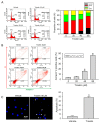Tricetin Induces Apoptosis of Human Leukemic HL-60 Cells through a Reactive Oxygen Species-Mediated c-Jun N-Terminal Kinase Activation Pathway
- PMID: 28758971
- PMCID: PMC5578057
- DOI: 10.3390/ijms18081667
Tricetin Induces Apoptosis of Human Leukemic HL-60 Cells through a Reactive Oxygen Species-Mediated c-Jun N-Terminal Kinase Activation Pathway
Abstract
Tricetin is a dietary flavonoid with cytostatic properties and antimetastatic activities in various solid tumors. The anticancer effect of tricetin in nonsolid tumors remains unclear. Herein, the molecular mechanisms by which tricetin exerts its anticancer effects on acute myeloid leukemia (AML) cells were investigated. Results showed that tricetin inhibited cell viability in various types of AML cell lines. Tricetin induced morphological features of apoptosis such as chromatin condensation and phosphatidylserine (PS) externalization, and significantly activated proapoptotic signaling including caspase-8, -9, and -3 activation and poly(ADP-ribose) polymerase (PARP) cleavage in HL-60 AML cells. Of note, tricetin-induced cell growth inhibition was dramatically reversed by a pan caspase and caspase-8- and -9-specific inhibitors, suggesting that this compound mainly acts through a caspase-dependent pathway. Moreover, treatment of HL-60 cells with tricetin induced sustained activation of extracellular signal-regulated kinase (ERK) and c-Jun N-terminal kinase (JNK), and inhibition of ERK and JNK by their specific inhibitors respectively promoted and abolished tricetin-induced cell apoptosis. Dichlorofluorescein (DCF) staining showed that intracellular reactive oxygen species (ROS) levels were higher in tricetin-treated HL-60 cells compared to the control group. Moreover, an ROS scavenger, N-acetylcysteine (NAC), reversed tricetin-induced JNK activation and subsequent cell apoptosis. In conclusion, our results indicated that tricetin induced cell death of leukemic HL-60 cells through induction of intracellular oxidative stress following activation of a JNK-mediated apoptosis pathway. A combination of tricetin and an ERK inhibitor may be a better strategy to enhance the anticancer activities of tricetin in AML.
Keywords: acute myeloid leukemia; apoptosis; c-Jun N-terminal kinase; reactive oxygen species; tricetin.
Conflict of interest statement
The authors declare no conflict of interest.
Figures






Similar articles
-
Cantharidic acid induces apoptosis of human leukemic HL-60 cells via c-Jun N-terminal kinase-regulated caspase-8/-9/-3 activation pathway.Environ Toxicol. 2018 Apr;33(4):514-522. doi: 10.1002/tox.22537. Epub 2018 Jan 18. Environ Toxicol. 2018. PMID: 29345422
-
Quercetin induces mitochondrial-derived apoptosis via reactive oxygen species-mediated ERK activation in HL-60 leukemia cells and xenograft.Arch Toxicol. 2015 Jul;89(7):1103-17. doi: 10.1007/s00204-014-1300-0. Epub 2014 Aug 20. Arch Toxicol. 2015. PMID: 25138434
-
3,6-Dihydroxyflavone induces apoptosis in leukemia HL-60 cell via reactive oxygen species-mediated p38 MAPK/JNK pathway.Eur J Pharmacol. 2010 Dec 1;648(1-3):31-8. doi: 10.1016/j.ejphar.2010.08.020. Epub 2010 Sep 16. Eur J Pharmacol. 2010. PMID: 20840847
-
Analysis of the Mechanisms of Action of Naphthoquinone-Based Anti-Acute Myeloid Leukemia Chemotherapeutics.Molecules. 2019 Aug 28;24(17):3121. doi: 10.3390/molecules24173121. Molecules. 2019. PMID: 31466259 Free PMC article. Review.
-
Death fuels growth: Emerging players bridging apoptosis and cell proliferation in Drosophila and beyond.Semin Cell Dev Biol. 2025 May;169:103602. doi: 10.1016/j.semcdb.2025.103602. Epub 2025 Mar 12. Semin Cell Dev Biol. 2025. PMID: 40081300 Review.
Cited by
-
MTA2 silencing attenuates the metastatic potential of cervical cancer cells by inhibiting AP1-mediated MMP12 expression via the ASK1/MEK3/p38/YB1 axis.Cell Death Dis. 2021 May 6;12(5):451. doi: 10.1038/s41419-021-03729-1. Cell Death Dis. 2021. PMID: 33958583 Free PMC article.
-
Dissecting Heterosis During the Ear Inflorescence Development Stage in Maize via a Metabolomics-based Analysis.Sci Rep. 2019 Jan 18;9(1):212. doi: 10.1038/s41598-018-36446-5. Sci Rep. 2019. PMID: 30659214 Free PMC article.
-
The natural alkaloid Jerantinine B has activity in acute myeloid leukemia cells through a mechanism involving c-Jun.BMC Cancer. 2020 Jul 7;20(1):629. doi: 10.1186/s12885-020-07119-2. BMC Cancer. 2020. PMID: 32635894 Free PMC article.
-
The Curcumin Analogue, EF-24, Triggers p38 MAPK-Mediated Apoptotic Cell Death via Inducing PP2A-Modulated ERK Deactivation in Human Acute Myeloid Leukemia Cells.Cancers (Basel). 2020 Aug 4;12(8):2163. doi: 10.3390/cancers12082163. Cancers (Basel). 2020. PMID: 32759757 Free PMC article.
-
In Vitro Evaluation of Pro- and Antioxidant Effects of Flavonoid Tricetin in Comparison to Myricetin.Molecules. 2020 Dec 11;25(24):5850. doi: 10.3390/molecules25245850. Molecules. 2020. PMID: 33322312 Free PMC article.
References
-
- Burnett A.K., Hills R.K., Milligan D.W., Goldstone A.H., Prentice A.G., McMullin M.F., Duncombe A., Gibson B., Wheatley K. Attempts to optimize induction and consolidation treatment in acute myeloid leukemia: Results of the MRC AML12 trial. J. Clin. Oncol. 2010;28:586–595. doi: 10.1200/JCO.2009.22.9088. - DOI - PubMed
MeSH terms
Substances
LinkOut - more resources
Full Text Sources
Other Literature Sources
Research Materials
Miscellaneous

